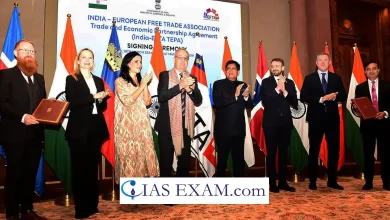Paradox of India’s Global Rise and its Regional Decline
GS Paper 2 - India and its Neighborhood, International Relations

Context
India’s global stature has undoubtedly grown in recent decades, influenced by its military prowess, economic might and demographic advantages. From being a prominent voice in global forums like G-20 and participating in multilateral groups like the I2U2, India has established itself as a significant player on the world stage.
However, India’s global rise is paradoxically accompanied by a concerning decline in its regional influence, particularly in South Asia, where it once held sway.
Factors behind India’s Global Rise
- Economic Growth – The World Bank projects that India’s production growth would reach 7.5% in FY24, powered by strong activity in services and industries. This economic power translates into global influence. For example, Indian enterprises such as Tata Consultancy Services have a substantial worldwide footprint. A strong economy encourages higher investments.
- Strategic Partnership & Alliances – India has actively sought strategic relationships and alliances with significant powers, including the Quadrilateral Security Dialogue (Quad) with the United States, Japan, and Australia. These partnerships have helped India overcome China’s expanding influence in the Indo-Pacific region and improve its global stature. Furthermore, India’s participation in world organizations such as the BRICS and the Shanghai Cooperation Organization has boosted its global footprint.
- Rising Military Might – India has progressively modernized, indigenized, and improved its military capabilities, transforming it into a formidable regional and global force. INS Sahyadri, LCA Tejas, and INS Vikrant are great examples of India’s recent military developments. India has delivered the first batch of BrahMos missiles to the Philippines, promoting defense diplomacy.
- Strategic Autonomy – India’s non-alignment and reformed multilateralism strategy, which includes abstaining from voting against Russia in the UN General Assembly and providing humanitarian aid to Israel while maintaining a clear diplomatic stance with Palestine, demonstrates its commitment to strategic autonomy and is widely praised.
- Technological Prowess – India’s technological breakthroughs, notably in information technology (IT), space exploration, and renewable energy, have contributed significantly to its worldwide rise. India’s recent successes with Chandrayaan-3 and the Aditya-L1 Mission demonstrate its strengths in the space domain. Furthermore, India’s leadership in the International Solar Alliance and the Global Biofuel Alliance illustrates its dedication to boosting renewable energy.
Factors behind India’s Regional Decline in South Asia
- China’s Rise – China’s significant economic investments, infrastructure projects under the Belt and Road Initiative, and diplomatic activities in South Asia have weakened India’s traditional area of influence in the region, resulting in a relative decline in India’s power and influence.
- Low Regional Trade – South Asia already has among the world’s lowest intra-regional trade levels. India’s trade with South Asian countries has been steady at around 1.7% to 3.8% of total global trade.
- Perception of Indian Hegemony – Some smaller South Asian states see India’s activities as an attempt to impose regional hegemony. This impression has created a sense of distrust and a desire to offset India’s power by balancing, bargaining, hedging, and bandwagoning tactics.
- Strained Relation with Neighbors – India’s ties with several of its neighbors have been strained for a variety of reasons, including border disputes, cross-border terrorism, and water-sharing concerns.
India’s main challenges with Neighboring Countries
- Pakistan – Kashmir dispute and cross-border terrorism remain the primary sources of tension between India and Pakistan. The Indus Water Treaty of 1960 allocates water rights from the Indus River system. However, disagreements over water sharing and infrastructure projects on the rivers remain a source of tension.
- China – While not strictly a South Asian nation, China’s growing influence in the region impacts India. A long-standing unresolved border dispute exists between India and China, particularly over the Line of Actual Control (LAC).
- Maldives – Recent Maldivian politics has seen a campaign called “India Out,” labeling Indian presence as a threat to sovereignty. This campaign, coupled with a tourism strain stemming from a diplomatic dispute and China’s rising influence in the Maldives, has sparked concerns about India-Maldives Relations.
- Bangladesh – India and Bangladesh have signed only 2 treaties out of 54 common rivers they share, including the Ganga Waters Treaty and The Kushiyara River Treaty. Negotiations are ongoing for major rivers like the Teesta and Feni. Also, illegal migration from Bangladesh to India, involving refugees and economic migrants, remains a significant issue, straining Indian border states and raising security concerns.
- Sri Lanka – The India-Sri Lanka relationship faces challenges such as tensions regarding ownership of Katchatheevu Island, concerns about border security and smuggling. It also includes sensitivity surrounding the Tamil minority issue in Sri Lanka, and India’s apprehensions about China’s growing influence in Sri Lanka (especially through Hambantota Port).
- Nepal – Although relations have improved recently, some lingering issues persist. It includes Boundary disputes, especially regarding the Kalapani-Limpiyadhura-Lipulekh trijunction area in western Nepal and the Susta area in southern Nepal.
Measures to enhance Regional Relationship
- Development-Centric Diplomacy: It is high time for India to move beyond just offering loans and focus on collaborative development projects that address specific needs in neighboring countries. This could involve joint research in areas like agriculture, renewable energy, or disaster management.
- Cooperative Security: India needs to shift towards a purely military-centric approach to security and promote cooperative security measures. This could involve joint counter-terrorism exercises, regional disaster response teams, or a South Asian hotline for managing border tensions.
- Focusing on Regional Blocs – Instead of attempting to control the whole area, India may focus on strengthening partnerships with sub-regional blocs such as BIMSTEC (Bay of Bengal Initiative for Multi-Sectoral Technical Cooperation) and SAARC (South Asian Association for Regional Cooperation). Success in these smaller groupings can lead to greater regional impact.
- Revitalising Neighbourhood First Policy – India must relook through its Neighbourhood First policy and prioritize inclusive development projects fostering mutual trust through transparent communication, and leveraging digital connectivity for collaborative initiatives within the region.
- South Asia at Heart of Global South – India can enhance its regional diplomatic ties by showcasing the South Asian region as a pivotal player in the Voice of Global South Summits. This approach can bolster India’s influence and cooperation within the region.
Conclusion
India’s ascent as a global power is juxtaposed with its waning influence in its immediate neighborhood. To reconcile this paradox, India must recalibrate its regional strategy, emphasizing development-centric diplomacy, cooperative security, and stronger sub-regional blocs. By revitalizing the Neighbourhood First policy and positioning South Asia at the forefront of the Global South narrative, India can restore its regional prominence. This balanced approach will not only mend strained relations but also fortify India’s position as a leader that champions collective progress and stability in South Asia.
SOURCE: The Hindu





.png)



